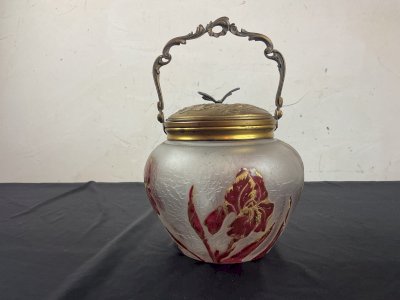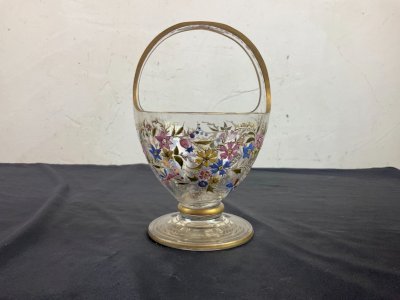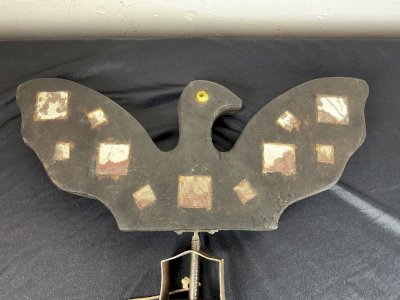- Sell Now
- Home
-
FURNISH
All STORAGE FURNITURE • Wardrobe • Chests of drawers, Chiffonnier • Sideboard • Shelves, Bookshelves • File cabinet • Sewing Furniture • Bar cabinet • TV Stand • Trunk, Chest TABLE & BEDSIDE TABLE • Dinner Table • Coffee table, side table, end table & Bedside • Console, Pedestal table & Selette • Serving Table, Trolley • Card Table • Draper's counter & table SEAT • Sofa • Armchair • Chair • Stool • Bench • Daybed • Beanbag & Footrest • Deckchair & Outdoor DESK, SECRETARY, DRESSING TABLE GARDEN LOUNGE BEDDING • Bed • Bedhead • Cradle, Moses basket CRAFT FURNITURE, WORKSHOP • Workbench • Stool, Ladder, Step • Easel & Trestle SCREEN PIANO
-
DECORATE
All TO PUT • Sculpture, Statuette • Vase & Planter • Dame Jeanne, Bonbonne & Flacon • Bridal globe, Dome • Pin tray, Ashtray • Candlestick & Candle • Photo frame • Stone, Fossil, Mineral • Earth Globe MIRROR WALL DECORATION • Painting • Engraving & Illustration • Poster • Tapestry • Wall Frame • Plate & Sign • Juju Hat & Wall Paniel • Mask • Hunting Trophy • Other object to hang CLOCK, PENDULUM & ALARM CLOCK ARRANGEMENT • Jar, Box & Case • Basket, Wastebasket & Crates • Magazine Rack & Vinyl Holder • Display & Spinner • Coat hook & Coat rack • Furniture Valet & Mannequin • Towel Holder • Suitcase & Travel Bag • Bottle Rack • Umbrella holder BATHROOM OFFICE • Mail holder • Bookends • Sulphide & Paperweight • Stationery FIREPLACE ACCESSORIES HOBBIES • Vintage Sport • Music • Vintage device • Smoking Item • Militaria, Ancient weapon • Miniature Vehicle • Game, Playing Cards • Collection object & Curiosity BIRD CAGE RELIGION, SPIRITUALITY
- TEXTURE
- ILLUMINATE
-
ACCOMODATE
All TABLE & SERVING • Plate • Silverware • Knife Holder • Glass • Bowl, Mug, Cup • Bowl, Ramekin & Cup • Dish, Cup & Salad Bowl • Tray, Basket & Server • Table Mat • Pitcher, Carafe, Bottle, Tea & Coffee Jug • Ice Bucket • Salt & Pepper shakers, Oil & Vinegar shakers • Sugar and jam maker • Gravy boat • Butter dish • Egg cup • Terrine OLD BALANCE CUTTING BOARD GRINDER CASSEROLE, SAUCEPAN & PAN KITCHEN UTENSIL & ACCESSORY
- TINKER
- KIDS
- Jewelry & Accessories
Login
Description
Height: 50 cm Weight: 9.7 kg Biography: Albert-Ernest Carrier de Belleuse, known as Carrier-Belleuse (1824-1887), was one of the most prolific artists of the century and enjoyed the greatest success under the Second Empire, benefiting from the personal support of Napoleon III. His work was greatly influenced by the style of the Italian Renaissance and that of the 18th century, which he helped to bring back into fashion. In 1837, the young Carrier-Belleuse began an apprenticeship in the workshop of the chaser Bauchery. He was admitted shortly afterwards to the goldsmith Jacques Henri Fauconnier. Through François Arago, he met the sculptor David d'Angers who facilitated his admission to the École des Beaux-Arts. Carrier-Belleuse joined the company in 1840. Noted for his skill by the great bronze houses of Paris such as Barbedienne and Denière, he soon received numerous orders for models for candelabras, clocks, mantelpieces, etc. In 1848, probably at the initiative of François Arago who had become head of state, he received his first public order for a small statue of Mademoiselle Rachel singing La Marseillaise. In 1851, he appeared for the first time at the Salon des artistes français, where he presented two bronze medallions. From 1851 to 1855, Carrier-Belleuse stayed in England, in Stoke-on-Trent where he worked as director of the modeling and drawing school of the house of Mintons, a large porcelain manufacturer. Back in France, Carrier-Belleuse settled in Paris in a large workshop located at 15 rue de la Tour d’Auvergne. From 1857 onwards, he regularly sent works to the Salon and became famous thanks to the success of his large marbles, such as the Bacchante exhibited at the Salon of 1863, and acquired by Napoleon III, Angelica (1866) and Hebe asleep (1869). At the Salon of 1867, his group entitled The Messiah earned him the medal of honour for sculpture. It was acquired by the State to decorate the chapel of the Virgin in the church of Saint-Vincent-de-Paul. At the same time, Carrier-Belleuse acquired a great reputation for his terracotta busts which, in many ways, recall those of 18th century artists. He executed portraits of a large number of celebrities of his time. He thus produced, among others, the busts of Napoleon III, Renan, Thiers, Grévy, Arago, Marguerite Bellanger, Théophile Gautier, Honoré Daumier, Delacroix, Hortense Schneider, Réjane… He also modeled many busts of mythological inspiration and a series of historical and artistic portraits such as Mary Stuart, Shakespeare and Mozart. Carrier-Belleuse employed and trained in his workshop on rue de la Tour d’Auvergne many talented young artists including Alexandre Falguière, Jules Desbois, Eugène Delaplanche, Jules Dalou and Joseph Chéret; but he is best known for having been the master of Auguste Rodin who joined his workshop as a practitioner in 1864. Suzanne - Albert-ernest Carrier-belleuse (1824-1887) Height: 50 cm Carrier-Belleuse devoted much of his time to decorative sculpture. He contributed to the decorations of many important buildings. He is notably responsible for the caryatids of the Renaissance theatre, the pediment of the main entrance of the Banque de France, the stucco ceilings of the Lesdiguières and La Trémoïlle pavilions at the Palais du Louvre, the frieze of the Palais de la Bourse in Brussels, and the decoration of the Hôtel de la Païva on the Champs-Elysées in Paris. He also received government commissions for monuments: that of Jean-Jacques Rousseau in Montmorency, of Alexandre Dumas in Villers-Cotterêts, of Masséna in Nice. Abroad, he created the equestrian statue of Michel le brave in Bucharest and the tomb of José de San Martín in Buenos Aires. In 1873, Carrier-Belleuse took part in the construction of the Paris Opera directed by his friend Charles Garnier. He created the two monumental torches that flank the grand staircase in the main hall and the caryatids of the fireplace in the grand foyer. In 1875, he was appointed director of artistic works at the Manufacture de Sèvres. He gave it a very modern impetus, which was manifested by the creation of a complete range of vases. Authenticity: Original Type: Statue, Sculpture Period: 19th century and before Material: Bronze Characteristics: Signed, On base Dimension (cm): From 51 to 70 Theme: Character
Réf :
#299318
Related Products
Comments
Suzanne - Albert-ernest Carrier-belleuse (1824-1887)
4 900€
4 459,00€
-9%
38300 Saint-Agnin-sur-Bion
Ce site contient des liens d’affiliation pour lesquels je peux recevoir une compensation.
Description
Height: 50 cm Weight: 9.7 kg Biography: Albert-Ernest Carrier de Belleuse, known as Carrier-Belleuse (1824-1887), was one of the most prolific artists of the century and enjoyed the greatest success under the Second Empire, benefiting from the personal support of Napoleon III. His work was greatly influenced by the style of the Italian Renaissance and that of the 18th century, which he helped to bring back into fashion. In 1837, the young Carrier-Belleuse began an apprenticeship in the workshop of the chaser Bauchery. He was admitted shortly afterwards to the goldsmith Jacques Henri Fauconnier. Through François Arago, he met the sculptor David d'Angers who facilitated his admission to the École des Beaux-Arts. Carrier-Belleuse joined the company in 1840. Noted for his skill by the great bronze houses of Paris such as Barbedienne and Denière, he soon received numerous orders for models for candelabras, clocks, mantelpieces, etc. In 1848, probably at the initiative of François Arago who had become head of state, he received his first public order for a small statue of Mademoiselle Rachel singing La Marseillaise. In 1851, he appeared for the first time at the Salon des artistes français, where he presented two bronze medallions. From 1851 to 1855, Carrier-Belleuse stayed in England, in Stoke-on-Trent where he worked as director of the modeling and drawing school of the house of Mintons, a large porcelain manufacturer. Back in France, Carrier-Belleuse settled in Paris in a large workshop located at 15 rue de la Tour d’Auvergne. From 1857 onwards, he regularly sent works to the Salon and became famous thanks to the success of his large marbles, such as the Bacchante exhibited at the Salon of 1863, and acquired by Napoleon III, Angelica (1866) and Hebe asleep (1869). At the Salon of 1867, his group entitled The Messiah earned him the medal of honour for sculpture. It was acquired by the State to decorate the chapel of the Virgin in the church of Saint-Vincent-de-Paul. At the same time, Carrier-Belleuse acquired a great reputation for his terracotta busts which, in many ways, recall those of 18th century artists. He executed portraits of a large number of celebrities of his time. He thus produced, among others, the busts of Napoleon III, Renan, Thiers, Grévy, Arago, Marguerite Bellanger, Théophile Gautier, Honoré Daumier, Delacroix, Hortense Schneider, Réjane… He also modeled many busts of mythological inspiration and a series of historical and artistic portraits such as Mary Stuart, Shakespeare and Mozart. Carrier-Belleuse employed and trained in his workshop on rue de la Tour d’Auvergne many talented young artists including Alexandre Falguière, Jules Desbois, Eugène Delaplanche, Jules Dalou and Joseph Chéret; but he is best known for having been the master of Auguste Rodin who joined his workshop as a practitioner in 1864. Suzanne - Albert-ernest Carrier-belleuse (1824-1887) Height: 50 cm Carrier-Belleuse devoted much of his time to decorative sculpture. He contributed to the decorations of many important buildings. He is notably responsible for the caryatids of the Renaissance theatre, the pediment of the main entrance of the Banque de France, the stucco ceilings of the Lesdiguières and La Trémoïlle pavilions at the Palais du Louvre, the frieze of the Palais de la Bourse in Brussels, and the decoration of the Hôtel de la Païva on the Champs-Elysées in Paris. He also received government commissions for monuments: that of Jean-Jacques Rousseau in Montmorency, of Alexandre Dumas in Villers-Cotterêts, of Masséna in Nice. Abroad, he created the equestrian statue of Michel le brave in Bucharest and the tomb of José de San Martín in Buenos Aires. In 1873, Carrier-Belleuse took part in the construction of the Paris Opera directed by his friend Charles Garnier. He created the two monumental torches that flank the grand staircase in the main hall and the caryatids of the fireplace in the grand foyer. In 1875, he was appointed director of artistic works at the Manufacture de Sèvres. He gave it a very modern impetus, which was manifested by the creation of a complete range of vases. Authenticity: Original Type: Statue, Sculpture Period: 19th century and before Material: Bronze Characteristics: Signed, On base Dimension (cm): From 51 to 70 Theme: Character
Réf :
#299318
 English
English  Français
Français 


























